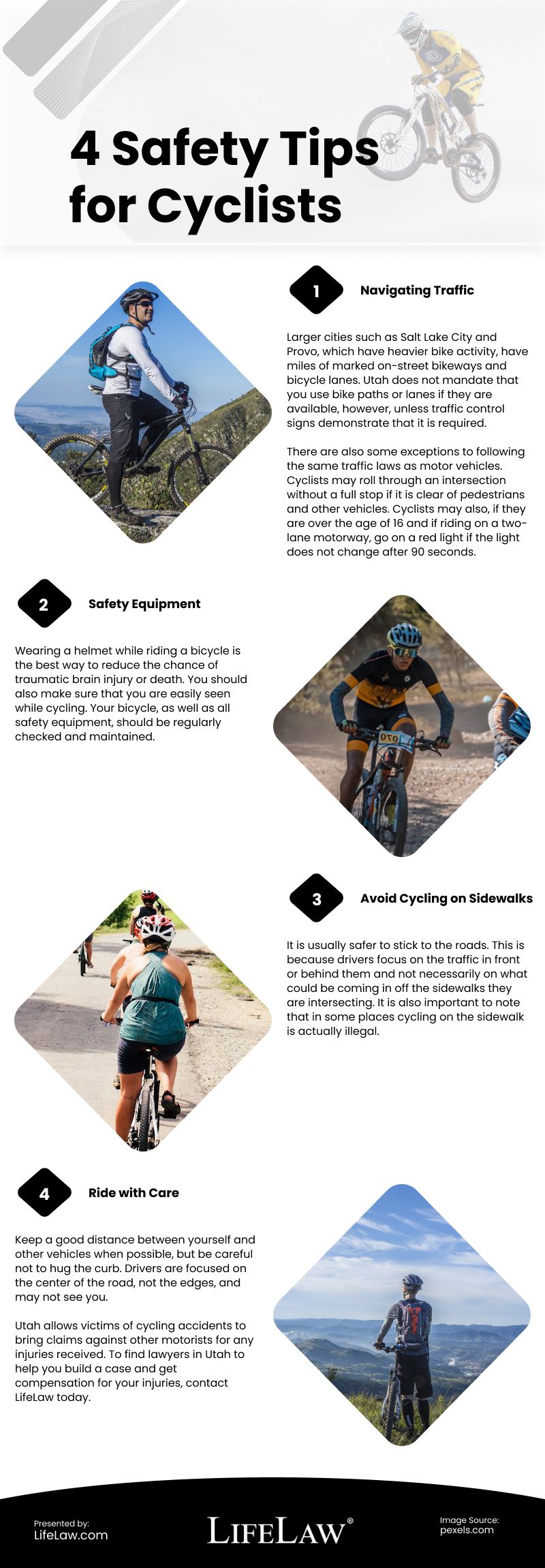
Biking is a fun and healthy activity that also benefits the environment. However, it comes with significant risks. The National Safety Council reports a 44% increase in preventable deaths from bike accidents over the last decade. Advocates in Utah are urging increased attention toward bike safety following a series of fatal spring biking accidents that have highlighted the risks of cycling.
Navigating Utah’s cities and communities on a bicycle can be challenging as they are primarily designed for automobiles. While bike lanes are available in certain areas, cycling can still pose safety risks. If you enjoy cycling for leisure or as part of your daily commute, here are some useful tips to stay safe on the road.
Navigating Traffic
In Utah, bikes are considered vehicles and have the same responsibilities and rights as any other vehicle on the road. It is important to ride with the flow of traffic and in the same direction. In larger cities like Salt Lake City and Provo, there are plenty of marked on-street bikeways and bicycle lanes available due to heavier bike activity. While Utah does not require the use of bike paths or lanes unless traffic control signs indicate otherwise, it is still recommended to use them whenever possible.
While cyclists are generally required to follow the same traffic laws as motor vehicles, there are some exceptions. For example, if there are no pedestrians or other vehicles present, cyclists may roll through an intersection without coming to a complete stop. Additionally, if a cyclist is over the age of 16 and riding on a two-lane motorway, they may proceed through a red light if it has not changed after 90 seconds. This is to ensure that traffic keeps moving and to reduce the vulnerability of cyclists while stopping and starting again.
In Utah, there is a law that prohibits motor vehicles from operating within three feet of a moving bicycle to protect cyclists. This law ensures their safety while passing.
Safety Equipment
Although it is not mandatory for cyclists to wear helmets in Utah, wearing one every time to ride a bike is highly advised by bike accident attorneys who have witnessed numerous devastating outcomes from bike crashes. Wearing a helmet significantly decreases the risk of severe head injuries or even death. It is crucial to ensure that your helmet fits you properly and is the appropriate size for maximum protection, just like any other safety equipment.
When cycling, it’s crucial to be visible to others on the road. Wearing bright-colored clothing and reflective strips or vests can help with this. Additionally, your bike should have proper lighting, even if you typically ride during the day. A white light at the front and red reflectors on the back can significantly improve your visibility.
It’s important to regularly check and maintain your bicycle and safety equipment. In Utah, police officers have the authority to inspect your bike if they suspect it doesn’t meet basic safety standards.
Avoid Cycling on Sidewalks
If you’re stuck in heavy motor vehicle traffic, you might consider cycling on the sidewalk. However, it’s generally safer to stay on the road. This is because drivers are typically paying attention to the traffic in front of or behind them, and not what’s coming from the sidewalks they’re crossing. It’s worth noting that in some places, cycling on the sidewalk is illegal. In areas with high traffic and no shoulder or multiple lanes, the sidewalk may be the only option. In this case, proceed with extra caution.
Ride with Care
Although there are laws in place to protect cyclists, cycling can still be hazardous. However, riding with caution and awareness can reduce the risk of serious injury. It’s important to maintain a safe distance from other vehicles, but avoid riding too close to the curb. Drivers tend to focus on the center of the road and may not notice you if you’re too close to the edge. Additionally, the curb or edge of the road often has debris, gravel, and uneven pavement that could cause you to lose control of your bike.
While we trust that drivers are watchful when sharing the road with cyclists, it is equally important for cyclists to be attentive to drivers. It is recommended to establish eye contact and provide clear signals to drivers of nearby vehicles to convey your intentions when turning, slowing down, or stopping. Intersections are a common location for cycling accidents, so extra caution is necessary when stopping and starting. In case of any miscommunication, always be prepared to brake.
If you have been injured in a cycling accident in Utah, you have the right to seek compensation from the other motorist involved. To get help with building a case and receiving compensation, contact LifeLaw for assistance in finding lawyers in Utah.
source: https://lifelaw.com/staying-safe-as-a-cyclist-in-utah/
Comments
Download this infographic.
